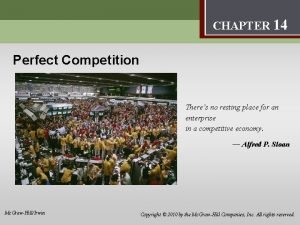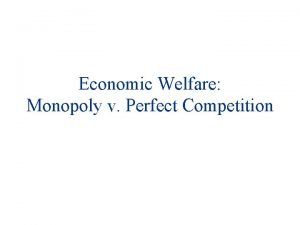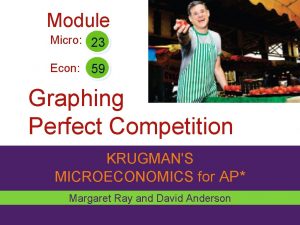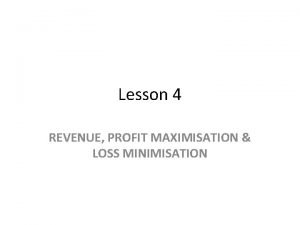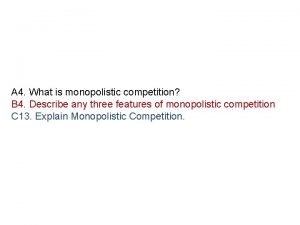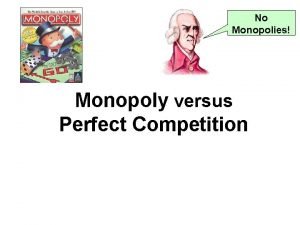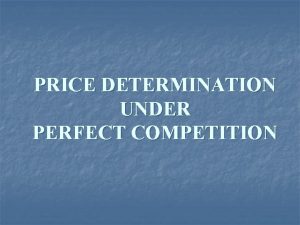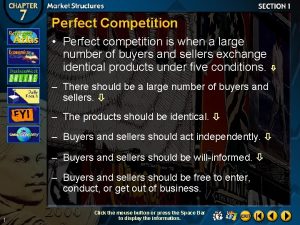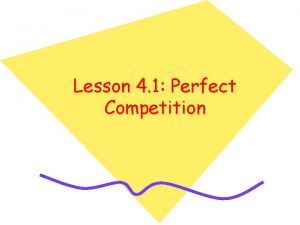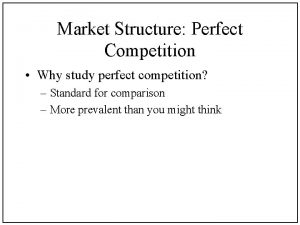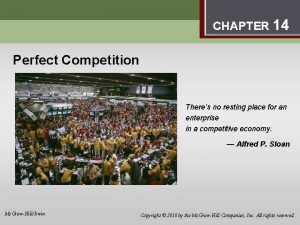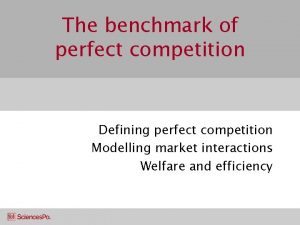Perfect Competition Perfect competition is when a large















- Slides: 15

Perfect Competition • Perfect competition is when a large number of buyers and sellers exchange identical products under five conditions. – There should be a large number of buyers and sellers. – The products should be identical. – Buyers and sellers should act independently. – Buyers and sellers should be well-informed. – Buyers and sellers should be free to enter, conduct, or get out of business. 1 Click the mouse button or press the Space Bar to display the information.

Perfect Competition (cont. ) • Under perfect competition, supply and demand set the equilibrium price, and each firm sets a level of output that will maximize its profits at that price. • Imperfect competition refers to market structures that lack one or more of the five conditions of perfect competition. 2 Click the mouse button or press the Space Bar to display the information.

Discussion Question Imagine that your town had an open farmers’ market during the spring and summer. How would it meet each condition for a perfectly competitive market? 3 Click the mouse button or press the Space Bar to display the answer.

Discussion Question It would draw many buyers and sellers; the products would be farmgrown vegetables and fruits; prices would be set based on the week’s harvest (supply) and buyers’ demand; buyers examine and select products firsthand; and buyers may choose not to purchase and sellers may choose not to participate or not to offer all farm products. 4 Click the mouse button or press the Space Bar to display the answer.

Section 1: Competition and Market Structures Perfect competition is a market structure with a large numbers of buyers and sellers, identical economic products, independent action by buyers and sellers, reasonably wellinformed participants, and freedom for firms to enter or leave the market. Perfect competition is a largely theoretical situation used as a benchmark to evaluate other market structures. Market situations lacking one or more of these conditions are called imperfect competition. 5 Click the mouse button or press the Space Bar to display the information.

Monopoly A monopoly is a market structure with only one seller of a particular product. The United States has few monopolies because Americans prefer competitive trade, and technology competes with existing monopolies. Natural monopoly occurs when a single firm produces a product or provides a service because it minimizes the overall costs (public utilities). economies of scale: a situation in which the average cost of production falls as the firm gets larger 6 Click the mouse button or press the Space Bar to display the information.

Monopoly Geographic monopoly occurs when the location cannot support two or more such businesses (small town drugstore). 7 Click the mouse button or press the Space Bar to display the information.

Monopoly (cont. ) Technological monopoly occurs when a producer has the exclusive right through patents or copyrights to produce or sell a particular product (an artist’s work for his lifetime plus 50 years). Government monopoly occurs when the government provides products or services that private industry cannot adequately provide (uranium processing). The monopolist is larger than a perfect competitor, allowing it to be the price maker versus the price taker. 8 Click the mouse button or press the Space Bar to display the information.

Discussion Question Why are monopolies unappealing to Americans? students should indicate an understanding of the benefits of the free enterprise system and economic and social goals. 9 Click the mouse button or press the Space Bar to display the answer.

Monopolistic Competition Monopolistic competition meets all conditions of perfect competition except for identical products. Monopolistic competitors use product differentiation—the real or imagined differences between competing products in the same industry. 10 Click the mouse button or press the Space Bar to display the information.

Monopolistic Competition Monopolistic competitors use nonprice competition, the use of advertising, giveaways, or other promotional campaigns to differentiate their products from similar products in the market. Monopolistic competitors sell within a narrow price range but try to raise the price within that range to achieve profit maximization. 11 Click the mouse button or press the Space Bar to display the information.

Discussion Question What are some examples of how different jean companies differentiate their products? style, available sizes, fabric, younger market, etc. 12 Click the mouse button or press the Space Bar to display the answer.

Oligopoly is a market structure in which a few very large sellers dominate the industry. Oligopoly is further away from perfect competition (freest trade) than monopolistic competition. Oligopolists act interdependently by lowering prices soon after the first seller announces the cut, but typically they prefer nonprice competition because their rival cannot respond as quickly. 13 Click the mouse button or press the Space Bar to display the information.

Oligopoly (cont. ) Oligopolists may all agree formally to set prices, called collusion, which is illegal (because it restricts trade). Two forms of collusion include: – price-fixing, which is agreeing to charge a set price that is often above market price – dividing up the market for guaranteed sales. 14 Click the mouse button or press the Space Bar to display the information.

Oligopoly (cont. ) Oligopolists can engage in price wars, or a series of price cuts that can push prices lower than the cost of production for a short period of time. Oligopolists’ final prices are likely to be higher than under monopolistic competition and much higher than under perfect competition. 15 Click the mouse button or press the Space Bar to display the information.
 Competition refers to
Competition refers to Perfect competition vs monopolistic competition
Perfect competition vs monopolistic competition Monopoly vs monopolistic competition
Monopoly vs monopolistic competition Monopoly vs oligopoly venn diagram
Monopoly vs oligopoly venn diagram Past perfect present perfect future perfect
Past perfect present perfect future perfect Hello
Hello Disadvantages of perfect competition
Disadvantages of perfect competition Shut down point
Shut down point Allocative efficiency in monopoly
Allocative efficiency in monopoly Long run supply curve
Long run supply curve Graphing perfect competition
Graphing perfect competition Three characteristics of perfect competition
Three characteristics of perfect competition Perfect competition profit maximization
Perfect competition profit maximization A market dominated by a single seller
A market dominated by a single seller Supernormal profit in perfect competition
Supernormal profit in perfect competition P = mc
P = mc







